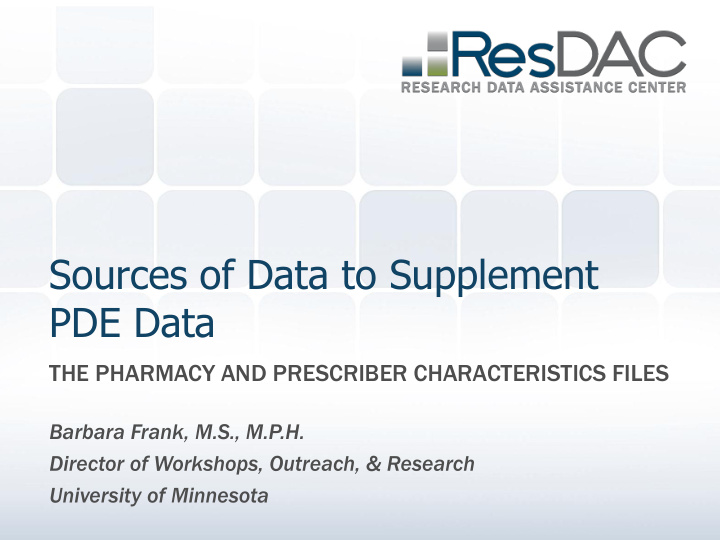



Sources of Data to Supplement PDE Data THE PHARMACY AND PRESCRIBER CHARACTERISTICS FILES Barbara Frank, M.S., M.P.H. Director of Workshops, Outreach, & Research University of Minnesota
Acronyms CCW – Chronic Condition Warehouse Buccaneer PDE – Part D Event NPI – National Provider Identifier DEA – Drug Enforcement Administration UPIN – Unique Provider Identification Number NCPDP - National Council for Prescription Drug Programs NUCC – National Uniform Claims Committee 2
Review of Characteristics Files Unencrypted Provider (Pharmacy) and Prescriber identifiers will not be released to external researchers. Encrypted variables cannot be linked to outside data sources such as NPI, DEA or UPIN files OR linked to other Part A or B data file variables. CCW provides information regarding the prescriber and the pharmacy due to encryption of variables in PDE file. 3
Sources for Characteristics Files The primary source data for the CCW Prescriber Characteristics File is the National Council for Prescription Drug Programs (NCPDP) HCIDEA TM PRESCRIBER DATABASE FILE STANDARD. Taxonomy codes are assigned by the National Uniform Claims Committee (NUCC). 4
Sources for Characteristics Files CCW Pharmacy data source is an end-of-year snapshot of the historical NCPDP DATAQTM Pharmacy Database File Standard. CCW has obtained permission from the NCPDP to release information for research purposes. 5
Encrypted Identifiers When the PDE data was first released there were 4 variables to identify provider and prescriber available in the data. ˗ Service Provider ID (Encrypted) ˗ Service Provider ID Qualifier ˗ Prescriber ID (Encrypted) ˗ Prescriber ID Qualifier 6
Encrypted Identifiers By the end of 2010, CCW created the Pharmacy Characteristic and Prescriber Characteristic files back to 2006. In turn, 2 new encrypted identifiers were created – the CCW Pharmacy ID and the CCW Prescriber ID. Both IDs are encrypted differently than their predecessor. 7
Encrypted Identifiers For researchers that have already received PDE data and request characteristic files at a later date, a cross-walk file is also included with the characteristic files. This cross-walk file contains variables needed to cross-walk the PDE record to the CCW new encrypted variable for the respective file. Variables: PDE_ID, Bene_ID, Service Date, CCW Prescriber/Pharmacy ID, and PDE Prescriber Format Code. 8
Pharmacy Characteristic File Useful to determine: Type of dispenser State location of dispenser Relationship to a parent organization File can change from year to year, so be sure to use respective annual file 9
Pharmacy Characteristic File Dispenser Class The Dispenser Class Code is self-designated and is not related to taxonomy codes. Most classified as either a Chain pharmacy (61%) or an independent pharmacy (35%) 10
Pharmacy Characteristic File Primary Dispenser Type More detailed than Dispenser Class Related to taxonomy codes Identifies Community/Retail pharmacy, Long Term Care pharmacy, Mail Order pharmacy Examples: ˗ 3336C0003X – Community/Retail Pharmacy ˗ 3336L0003X - Long Term Care Pharmacy ˗ 332800000X – Mail Order Pharmacy 11
Pharmacy Characteristic File Primary Taxonomy Code Or you can use specific Taxonomy code Must link to taxonomy code list to identify Same results as Dispenser Type 12
Pharmacy Characteristic File Relationship Information Four Variables ˗ Relationship ID ˗ Relationship From Date ˗ Relationship Thru Date ˗ Relationship Type 13
Pharmacy Characteristic File Relationship Information Relationship ID is an encrypted variable that allows you to group chain pharmacies under a parent organization. Beginning /ending date of relationship in file Encryption same across years Cannot identify name of parent organization Relationship Type identifies whether it is a chain (~98%) or a franchise (~2%). Blank if provider has no chain or franchise relationships. 14
Relationship ID Relationship Type=02 (Franchise) Encrypted Relationship ID Cumulative Cumulative RELATIONSHIP_ID Frequency Percent Frequency Percent 9xe 591 62.01 591 62.01 e8e 3 0.31 594 62.33 k9o 177 18.57 771 80.9 o9D 5 0.52 776 81.43 odd 5 0.52 781 81.95 oo9 4 0.42 785 82.37 r9x 49 5.14 834 87.51 rol 107 11.23 941 98.74 rrx 9 0.94 950 99.69 xkx 3 0.31 953 100 15
CCW Prescriber Characteristics File 16
Prescriber Characteristic File Contains 3 useful variables ˗ Primary Taxonomy Codes with Description ˗ Practice State listed as 2 CHAR Alpha code ˗ Credentials 17
Prescriber Characteristic File Primary Taxonomy Code Prescriber Specialty is listed under Taxonomy Codes and not the Specialty code used in Part B data. Examples ˗ 207Q00000X – Family Medicine ˗ 207R00000X – Internal Medicine ˗ 207RC0000X – Cardiovascular Disease ˗ 2084P0800X - Psychiatry 18
Prescriber Characteristic File Credentials – lists up to 5 but only the first is well populated. Examples ˗ MD ˗ DO ˗ PA ˗ NP 19
Resources For the National Uniform Claims Committee (NUCC) Provider Taxonomy Codes and Descriptions see the Code Sets link at http://www.nucc.org/ 20
Recommend
More recommend